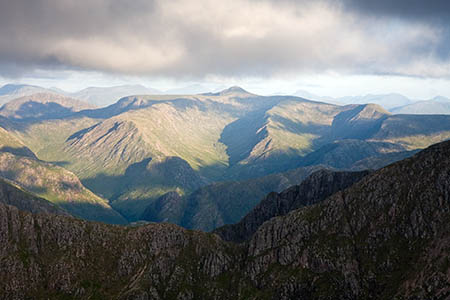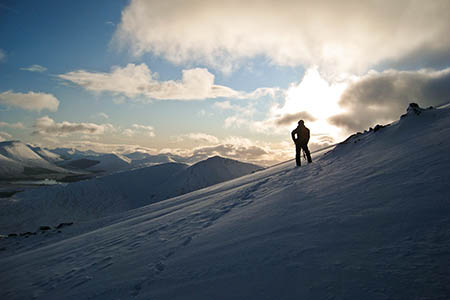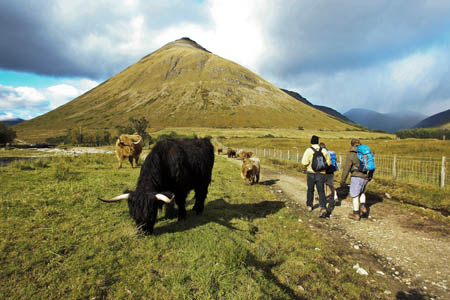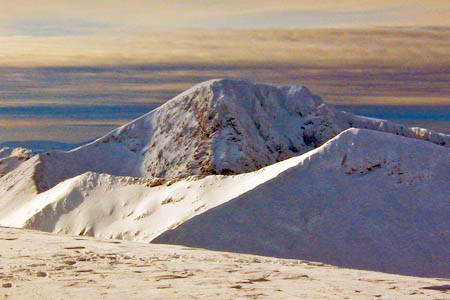Ramblers, mountaineers and conservationists welcomed the Scottish Government’s new policy that designates almost a fifth of the nation as wild land.
The publication of a wild land area map and adoption of new planning policies will protect some of Scotland’s best landscapes and mountain areas from development.
But the Mountaineering Council of Scotland expressed its disappointment that the new map has seen some areas excluded, including the site of the controversial proposed Stronelairg windfarm in the Monadhliath Mountains, which the Scottish Government recently approved.
The John Muir Trust, which campaigns for the protection of wild land and also owns tracts of Scotland’s mountains, including most of Ben Nevis, called the adoption of the new wild land map a historic breakthrough.
Scottish Natural Heritage, the government agency charged with producing the map, said it shows 42 wild land areas covering 19.5 per cent of Scotland. It replaces a map published in 2013 in support of the draft Scottish planning policy.
Speaking at the launch of the planning framework and policy, Ian Jardine, SNH chief executive, said: “One of our roles is to work with planners and developers to help get the right development in the right place.
“We do this by providing advice on nature and landscape. This new map helps to do this by identifying which are the key areas of wild land.
“We warmly welcome the Government’s recognition of these areas in the new national planning framework and the Scottish planning policy.”
“The planning documents launched today do much more than recognise the importance of the wild land resource. They also recognise the extensive role of nature and landscape in the wider sense, and people’s enjoyment of it, in achieving sustainable economic growth.
“The planned national walking and cycling network, for example, will offer broad health, active travel and tourism benefits. And the commitment to plan for green infrastructure is particularly important if we are to make better places for people to live and work in.”
The Mountaineering Council of Scotland broadly welcomed the announcement.
It said the ban on any windfarms in national parks or national scenic areas and the adoption of Scottish Natural Heritage’s map of core wild land areas means that a large part of Scotland will be better protected from inappropriate and large-scale developments.
MCofS landscape and access director Dave Gordon said: “We welcome this confirmation that windfarms are incompatible with national parks and national scenic areas.
“We also welcome the recognition of the importance of wild land, which includes most of Scotland’s mountain areas.
“However, we do regret the lack of stronger protection for wild land, which will lead to continued speculative attempts at unsuitable development.
“And it is unfortunate that there has been a reduction in the areas covered by the wild land areas 2014 map, compared to Scottish Natural Heritage’s original 2013 map. The areas removed include a part of the Monadhliath where, just this month, the Scottish Government approved the massive Stronelairg wind farm.”
The council said its recent survey showed the presence of wind farms was a disincentive for mountaineers to visit or revisit an area – a serious consideration when mountaineering tourism in Scotland has been valued at £600m a year, it added.
Ramblers Scotland said about 30 per cent of Scotland will be better protected from large scale, inappropriate developments, although the walking organisation also expressed concerns about the increased pressure for development on the large tracts of land outside of these areas.
Helen Todd, campaigns and policy manager at Ramblers Scotland said: “We are very pleased that the Scottish Government has finally recognised in planning policy the importance of wild land for Scotland.
“Wild land is a key tourism asset and a magnificent setting for outdoor recreation, but it is also part of our natural heritage, even our fundamental sense of identity as a nation.
“We are pleased to see the confirmation that no windfarms will be built within national parks or national scenic areas, and we hope that the adoption of Scottish Natural Heritage’s map of core areas of wild land within the Scottish planning policy will lead to a curtailment in the relentless march of giant onshore windfarms with the resulting attrition of our cherished wild areas.
“However, there are still large tracts of land which are exposed to these massive developments, and this will only be corrected by changes in the financial support regimes for windfarms to encourage them to be built offshore, not in fragile upland areas where they are totally out of scale with the landscape.
“Given the Scottish Government’s recent approval of the Stronelairg 67-turbine windfarm in the Monadhliath Mountains, right in the heart of one of these core areas of wild land, this doesn’t fill us with confidence that the new wild land policy will necessarily bring the proper protections we are looking for.
“We will be watching carefully to see whether the Government is really serious about protecting wild land, or whether this policy can be ripped up whenever a big developer comes along with big promises and a massive new wind farm scheme.”
Stuart Brooks, chief executive of the John Muir Trust said: “This recognition of Scotland’s wild land as a nationally important asset that needs to be safeguarded marks a historic breakthrough.
“Scotland’s landscapes are spectacular, contributing to our quality of life, our national identity and the visitor economy. The John Muir Trust has fought long and hard over many years with the support of many thousands of people to achieve official recognition for wild land and we welcome this commitment.
“Although this falls short of our request for the absolute protection of wild land from large scale developments, we applaud the Scottish Government for taking this bold step in the face of a sustained campaign to undermine wild land protection by powerful vested interests.
The trust said the new policy should discourage energy companies from targeting the 42 areas that make up the wild land map. But it too pointed out that areas such as Stronelairg had been removed from the original draft map.
Mr Brooks said: “Before commenting on the specific changes to the map, we will look more closely at the detailed explanations from SNH about the reasons for these removals. We will continue to defend those areas that we consider to be wild land from large scale development.”




Frank MacKenzie
24 June 2014Excellent article and at last our wild lands have some protection. I spent many a tiring but enjoyable day bashing the Munroes when I was on RAF MRT at both Leuchars & Kinloss. Being an ex-pat Scot I appreciate the work being done to stop the wind farms as they are an eye sore.
alan.sloman
24 June 2014Most people recognise that under the present administration and its desperation for electricity to export to rUK, the 'wild' lands have been sacrificed.
This Wild Land map exercise is the Scottish Government's way of tripping up anti-wind farm protesters. The big problem is that this new Wild Land Map is NOT a statutory instrument whilst the National Planning Framework is.
And of course the wind farm developers' legal teams (and the Scottish Government, of course) are well aware of this. If there's a specific profitable (with subsidies, of course) wind farm to be had in an area designated as "wild land" the Reporter will roll over as the National Planning Framework will win the day for the developer.
Both the JMT and the MCofS are aware of this, so I am amazed that they are showing so much support.
Lee
26 June 2014Very good news, though other posters bashing wind farms is a bit silly, as they are a good viable alternative to fossil fuels. I would like to see more work done to promote woodland, not vast areas of grass.
But all in all the news sounds good.
Caroline Snow
29 June 2014You see to be confusing wild land with farmed land. Your pictures show farm livestock grazing grassland. This is not the native vegetation that will support wild species and biodiversity, but the same old farm land dressed up as desirable countryside. It appears to be just an excuse to have a bash at wind turbines. Personally I would prefer a true wilderness that allows the return of our native wild species. Wind turbines would pose less of a threat to this landscape than the grazing of livestock.
Ben Stobbs
04 July 2014The primary development affecting the quality of wild spaces in Britain is the construction of wind farms. There is no disputing this fact. Wind farms are not sustainable. They have a 25 year design life, require large volumes of natural resources to supply the required steel, concrete and composite components utilised in their construction. Then there is the infrastructure required to support them which inevitably results in extensive habitat destruction in some of our most sensitive upland areas. Wind farms typically generate 25-28% of their design capacity per annum and cannot be described as a reliable source of renewable energy. They proliferate purely because of EU targets that the government has signed up to with regard to the percentage of energy that must be generated from renewable sources. It would be interesing to observe the results of a holistic approach to the calculation of the carbon generated by these installations over their complete lifecycle, in comparison to the actual emissions saved by the energy output generated. If they were efficient, energy companies would be clamouring to build turbines without the current level of government subsidy. The fact is, no subsidy = no turbines. The subsidy is currently funded through levys placed on our domestic fuel bills. The subsidy effectively stifles investment in researching alternative methods of generating sustainable energy, where subsidies aren't available, or are considerably less, as there is no commercial incentive to do so. Energy companies are driven by profit, as long as there is easy money to be made, land owners who want to line their pockets at the expense of society and politicians who hide behind the green banner, then this senseless destruction of our national heritage will continue. Be under no illusions, and try to look beyond the obvious. As far as the wild land map, it's a step in the right direction, but it is meaningless when held up against the destruction of the Monadhliath that will result from the Stronelairg development.